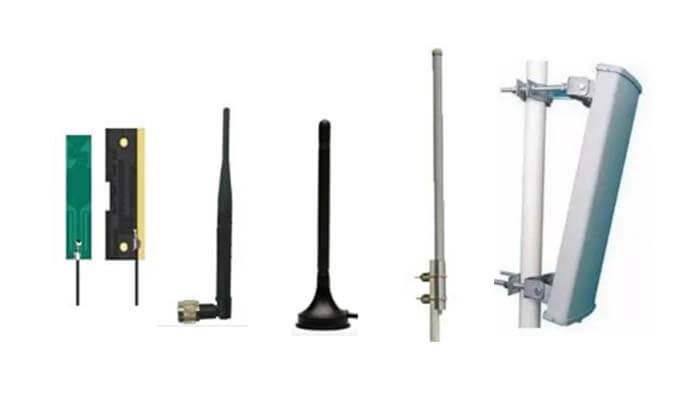What are the common types of antennas? How to choose the right types of antennas for the devices?
The types of antennas classification
The antenna is a device that radiates RF signal from the transmission line to air or receives it from air to the transmission line. It can also be regarded as an impedance converter or an energy transformer, which transforms the guided wave on the transmission line into an electromagnetic wave propagating in the unbounded medium, or the opposite transformation.
For the design of wireless transceiver equipment applied in the RF system, the design and selection of the antenna an essential part of it. A sound antenna system can make the communication distance to the best state, the same type of antenna size is proportional to the wavelength of the RF signal. The lower the frequency of the signal, the larger the required antenna.
The antenna by the installation position can be divided into two types of antennas, an external antenna type, and an internal antenna type, installed inside the internal antenna, and installed outside the external antenna.
For handheld devices, wearable designs, smart homes, and other small-size products, generally use the internal antenna, its integration is high, and the product appearance is beautiful. Internet of things and intelligent hardware products need to be networked to transmit data, so they all need antennas.
The smaller the space, the more frequency bands, and the more complex the antenna design. External antennas are generally standard products. The existing antenna can use the required frequency band antenna, no need to debug, plug, and play.
For example, courier cabinets and vending machines commonly use an external magnetic mount antenna sucked on the tin shell. These antennas cannot be placed inside the tin cabinet. Metal will shield the antenna signal that can only be placed outside. In this article from the antenna classification and selection method as the core, the antenna-related information is introduced.
Internal antenna of types of antennas
The external antenna can be divided into two types of antennas, an omnidirectional antenna and a directional antenna from the different directions of radiation field radiation angle.
Omni-directional antenna of types of antennas
In radio communication, an omnidirectional antenna is a class of antenna which radiates equal radio power in all directions perpendicular to an axis (azimuthal directions), with power varying with angle to the axis (elevation angle), declining to zero on the axis.
That is, in the horizontal direction of the map for 360 ° are uniform radiation, which is usually said to be directionless, in the vertical direction of the map for a certain width of the beam, in general, the smaller the width of the flap, the greater the gain.
Directional antenna of types of antennas
A directional antenna or beam antenna is an antenna that radiates or receives greater power in specific directions allowing increased performance and reduced interference from unwanted sources. Directional antennas provide increased performance over dipole antennas—or omnidirectional antennas in general—when a greater concentration of radiation in a certain direction is desired.
A directional antenna is in a particular direction or a particular direction to transmit and receive electromagnetic waves is particularly strong, and in other directions to transmit and receive electromagnetic waves is zero or very small a kind of antenna.
The purpose of using a directional transmitting antenna is to increase the effective utilization of radiated power and increase confidentiality;
The primary purpose of using a directional receiving antenna is to enhance the signal strength to increase the anti-interference ability.
External directional antenna mainly includes the sector antenna, Yagi antenna, and logarithmic period antenna.
Internal antenna of types of antennas
Internal antenna mainly refers to the antenna that a built-ina antenna can place inside the device. Built-in antenna mainly includes FPC antenna, PCB antenna, spring antenna, ceramic patch antenna, laser direct forming technology (LDS antenna), and metal sheet antenna.
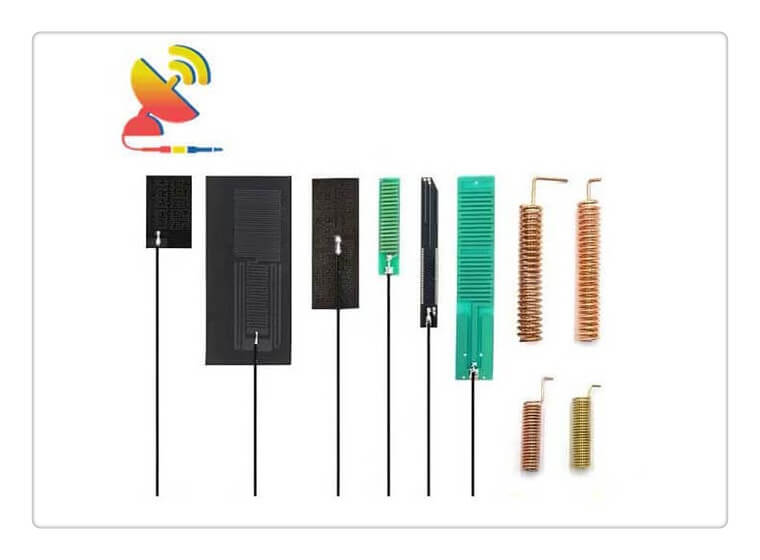
The types of antennas selection guide
In choosing the correct antenna type for the equipment/device/terminal, according to the product structure to determine the choice of internal or external antenna, an external antenna is installed outside the equipment.
Features of external antenna
High-gain;
Low impact by the environment;
Can be used as a standard product;
Save development cycle;
Occupy space affects the product’s beauty.
Features of internal antenna
Relatively high-gain;
Mature process, good product delivery consistency;
Built-in in the device, beautiful, no need to do three separate protection;
Affected by the surrounding environment, generally need to combine with the product itself to customize.
External antenna of types of antennas selection
First, need to determine the terminal signal coverage area. The radiation direction of the antenna determines the signal coverage direction. According to the antenna radiation direction, the antenna is divided into an omnidirectional antenna and a directional antenna.
Through-hole mount dome antenna
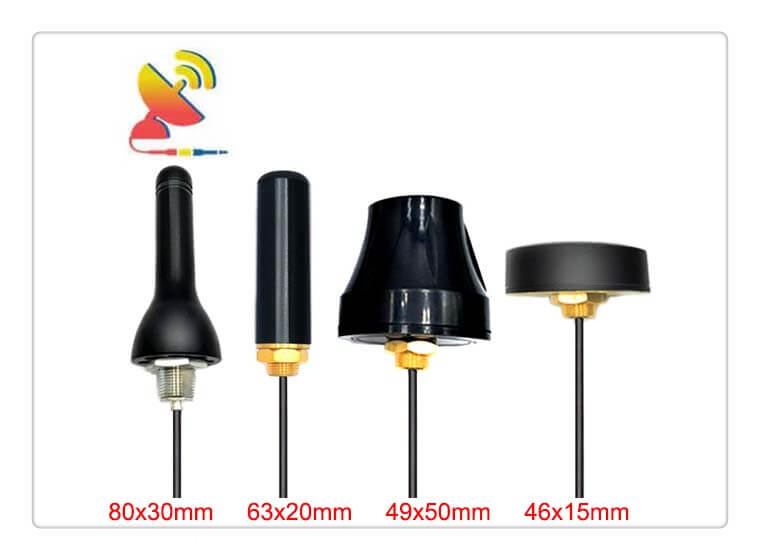
Omni-directional external through-hole mount dome antenna, that is, in the horizontal direction of the map performance for 360 ° are uniform radiation, which is usually directionless. And it has a through-hole screw mount antenna waterproof dome antenna for a robust environment.
Suitable for cabinets, DTUs, M2M, and IoT applications.
Magnetic mount antenna
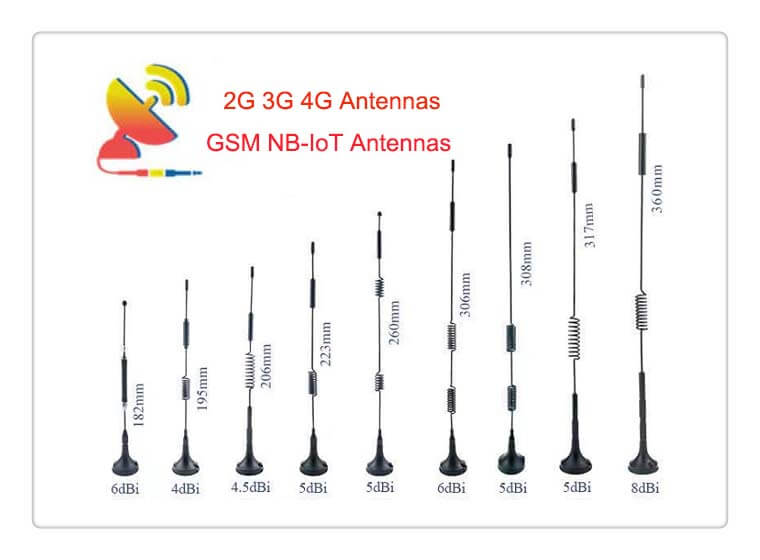
The gain is relatively high. The most prominent characteristic is that installation and fixing are very convenient with the magnetic solid suction cup, but the suction cup must be adsorbed on the metal surface. In the wireless module industry, a suction cup antenna is often used with the wireless module to increase the communication distance of wireless modules, such as intelligent meter reading, vending machine, express cabinet, car radio, etc.
Copper rod magnetic antenna
Like a standard whip antenna, the advantage over whip antenna magnetic mount sucker antenna is that it uses a pure copper radiator with a larger diameter, slight ohmic loss, high antenna efficiency, and comprehensive bandwidth coverage. It is suitable for digital transmission radio with relatively high-performance requirements, medium distance map transmission, etc.
Rubber duck antenna
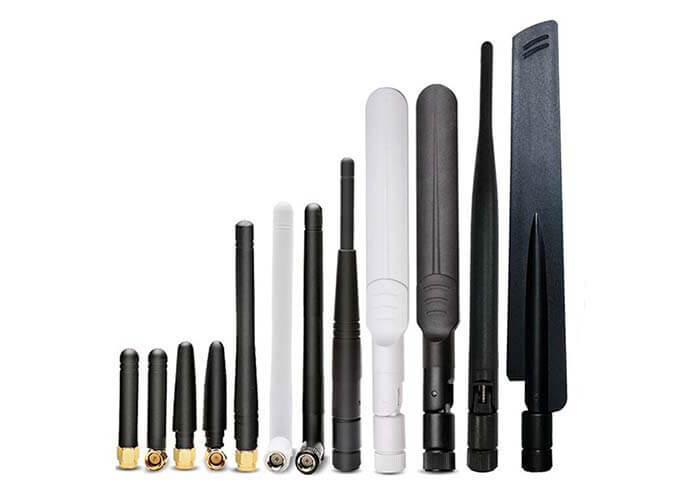
The most common external antenna rubber duck antenna’s gain is moderate, relatively low price, commonly used in wireless communication modules, wireless routing, digital transmission radio, etc.
You can choose the suitable size antenna according to the installation space requirements, choose the antenna size, and gain has a relationship. Usually, the longer the length of the same frequency band, the higher the gain.
Fiberglass antenna
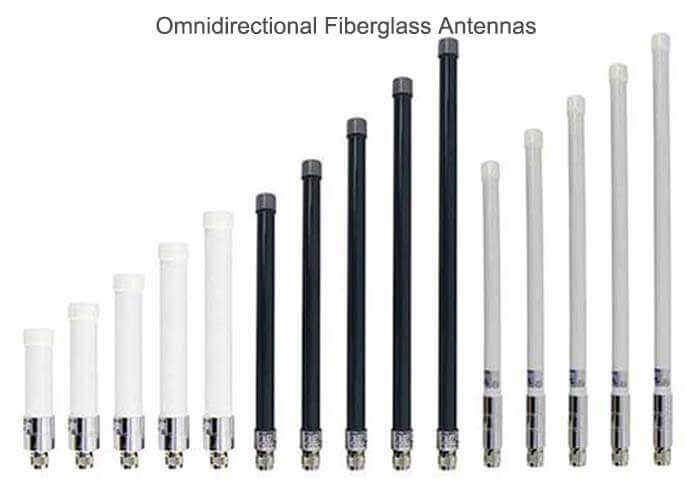
Among Omni-directional antennas, the Fiberglass antenna has the most excellent performance. Its inner core is a pure copper oscillator, using the balanced feed, with little influence from the environment;
The shell is high-quality glass steel, with good tri-proof characteristics and good adaptation to the harsh natural environment. Especially suitable for ultra-long-distance gateway signal coverage, image transmission, etc.
External directional antenna of types of antennas
Generally used for communication distance, signal coverage range is small, target density environment, extreme examples for point-to-point long-distance communication.
Sector antenna
High efficiency, medium size, and easy to install can consider the gain and radiation area.
Suitable for indoor, tunnel wireless signal coverage; medium distance signal transmission, map transmission and signal through the wall, etc.
Yagi Antenna
High gain, slightly large size, directional radiation, need to pay attention to the direction of the antenna when using, can be used for ultra-long distance signal transmission, map transmission and direction finding, etc.
Logarithmic period antenna
Ultra-broadband antenna, extensive bandwidth coverage, bandwidth up to 10:1, commonly used for signal amplification, indoor distribution, and elevator signal coverage.
Built-in antenna types of antennas selection
The form of the built-in antenna types of antennas can be divided into FPC antenna/PCB antenna/spring antenna/ceramic antenna/meta sheet antenna/Laser Direct Structuring (LDS antenna) and other types.
At present, the best choice is the FPC antenna and PCB antenna. For high-cost control and general performance requirements, choose spring antenna & metal sheet antenna are more; particular applications will choose ceramic patch antenna or LDS antenna, the general built-in antenna are affected by the environment, need a custom design or impedance matching.
FPC (Flexible Printed Circuit Board) antenna
With reasonable cost performance;
After spraying, oil can match with various appearance colors;
Good flexibility of the product can perfectly fit on the regular round surface;
Mature and stable process, fast production cycle, good batch deliverability;
Suitable for the antenna design of broadband intelligent devices with high-performance requirements.
PCB antenna (printed circuit board) antenna
The most significant difference between PCB and FPC antennas is that the FPC antenna has good flexibility and the PCB antenna is hardboard.
If you need to bend and curved surfaces in structure installation, choose an FPC antenna; if it is a flat place, you can choose a PCB antenna. PCB antenna is easier to install than an FPC antenna.
Spring antenna
Its most significant characteristic is cheap, but the gain is low, and the bandwidth is narrow; when inside the product, often need to debug the antenna matching.
Ceramic patch antenna
occupy very little space, better performance; narrow bandwidth, more challenging to do multi-band; effectively improve the integration of the motherboard, and can reduce the antenna to ID restrictions.
Need to import the design at the beginning of the definition of the motherboard.
LDS antenna
Suitable for a special appearance, the surface antenna can make full use of antenna space;
For antenna performance closer to the physical limits of the environment;
The antenna attached to the shell or bracket has special material requirements;
The process is mature and can be painted to match the color. The process has a specific rate of defect.
Metal sheet antenna
High-cost performance, effective cost reduction; high strength, not easy to break;
Mature and stable process, fast production cycle, good batch delivery;
The application of antenna area and circular appearance surface, has some limitations.
After reading about the common types of antennas, you already learned the types of antennas and how to choose the types of antennas when used in different conditions.
If you have any antenna questions, please read our ANTENNA FAQ section, if you still cannot get the answer you need, please contact us.
You may also be interested in the below articles.
Internal Antenna VS. External Antenna
LTE Vs. 5G: Is 5G Better Than LTE?

